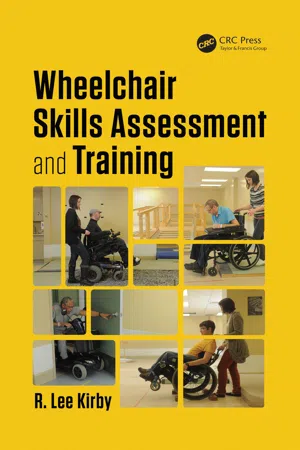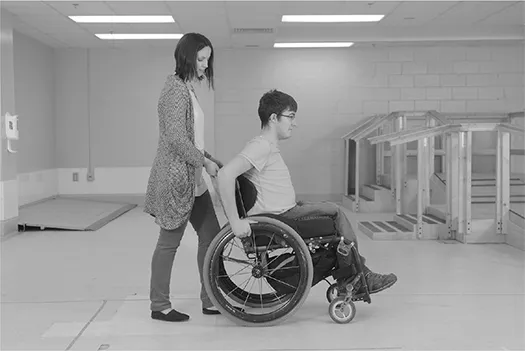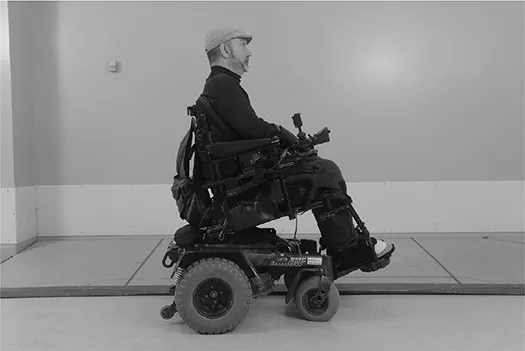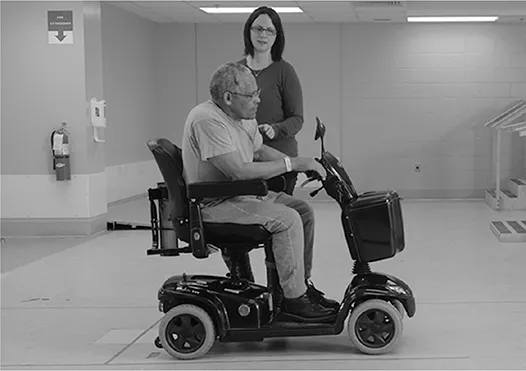
- 416 pages
- English
- ePUB (mobile friendly)
- Available on iOS & Android
eBook - ePub
Wheelchair Skills Assessment and Training
About this book
This book provides a wide spectrum of readers with comprehensive but easily understandable protocols for the assessment and training of wheelchair skills. The Wheelchair Research Team at Dalhousie University and the Capital District Health Authority in Halifax (lead by the author) have focused on wheelchair safety and performance for three decades, as exemplified through the Wheelchair Skills Program. This is considered the top such program in the world. This new book is largely based on this program which has been accessed and utilized by over 75, 000 people in 177 countries since 2007.
Frequently asked questions
Yes, you can cancel anytime from the Subscription tab in your account settings on the Perlego website. Your subscription will stay active until the end of your current billing period. Learn how to cancel your subscription.
At the moment all of our mobile-responsive ePub books are available to download via the app. Most of our PDFs are also available to download and we're working on making the final remaining ones downloadable now. Learn more here.
Perlego offers two plans: Essential and Complete
- Essential is ideal for learners and professionals who enjoy exploring a wide range of subjects. Access the Essential Library with 800,000+ trusted titles and best-sellers across business, personal growth, and the humanities. Includes unlimited reading time and Standard Read Aloud voice.
- Complete: Perfect for advanced learners and researchers needing full, unrestricted access. Unlock 1.4M+ books across hundreds of subjects, including academic and specialized titles. The Complete Plan also includes advanced features like Premium Read Aloud and Research Assistant.
We are an online textbook subscription service, where you can get access to an entire online library for less than the price of a single book per month. With over 1 million books across 1000+ topics, we’ve got you covered! Learn more here.
Look out for the read-aloud symbol on your next book to see if you can listen to it. The read-aloud tool reads text aloud for you, highlighting the text as it is being read. You can pause it, speed it up and slow it down. Learn more here.
Yes! You can use the Perlego app on both iOS or Android devices to read anytime, anywhere — even offline. Perfect for commutes or when you’re on the go.
Please note we cannot support devices running on iOS 13 and Android 7 or earlier. Learn more about using the app.
Please note we cannot support devices running on iOS 13 and Android 7 or earlier. Learn more about using the app.
Yes, you can access Wheelchair Skills Assessment and Training by R. Lee Kirby in PDF and/or ePUB format, as well as other popular books in Business & Service Industry. We have over one million books available in our catalogue for you to explore.
Information
Chapter 1 Introduction to the Wheelchair Skills Program (WSP)
1.1 Scope
The WSP is intended for manual wheelchairs (Figure 1.1) or powered wheelchairs (Figure 1.2), operated by wheelchair users or caregivers. The WSP can also be used for scooter users (Figure 1.3). Whenever appropriate, the word “wheelchair” used in the book should be understood to include scooters. Throughout the book, to simplify descriptions, unless otherwise specified, it has been assumed that the wheelchair being used is one with rear-wheel drive (i.e., large diameter wheels in back and smaller diameter swivel or steerable casters in front). Other types of wheelchairs and scooters can be dealt with using the WSP materials, but some of the instructions and explanations may need to be adapted accordingly. Wheelchair technology is diverse and evolving at a rapid rate. There may be wheelchairs that do not easily fit the categories described. In such situations, the tester or trainer needs to exercise judgment regarding which skills are appropriate. For instance, for power-assisted wheelchairs, a combination of skills from the manual and powered wheelchair skill sets would be appropriate.
The WSP is not intended to be an adequate approach for other important wheelchair skills (e.g., maintenance and repair skills), more extreme skills (e.g., some wheelchair sport activities), or community-integration activities that combine a number of skills (e.g., use of accessible transport and shopping). The skills chosen for inclusion in the WSP are intended to be representative of the range of skills that wheelchair users and/or caregivers may need to regularly perform, varying from the most basic to the more difficult. However, it would be impossible to be all-inclusive without making the size of the WSP unmanageable.
1.2 Subjects
In the book, the term “subject” is often used because the person who is the object of testing or training may be a wheelchair user, a caregiver, a healthcare student, or a research participant. In addition to testing or training for a wheelchair user and a single caregiver separately, the WSP may be used to assess or train the extent to which one or more caregivers and a wheelchair user can function as a team; the “subject” in such situations is the combination of the wheelchair user and the caregiver(s). Unless otherwise specified, the assumption is that it is a single person operating alone who is the subject. If an animal (e.g., a service dog) is used to assist with a skill, the animal is considered an “aid” rather than a caregiver.

Figure 1.1 Manual wheelchair.

Figure 1.2 Powered wheelchair with rear-wheel drive.

Figure 1.3 Scooter.
1.3 Special considerations for caregivers
If the usual circumstance for a skill in real life is that a wheelchair user and his/her caregiver ordinarily share the duties, then “blended” wheelchair user/caregiver testing or training may be the most appropriate choice, but the relative roles of the two people involved should be noted. It is not a reasonable expectation that a single caregiver could complete some skills alone without special equipment or the cooperation of the wheelchair user. The test score achieved is often a combination of the capacity of the wheelchair user and caregiver functioning together (i.e., a “blended” score). The caregiver-assisted score is specific not only to the wheelchair and setting (as is the case for the WST in general), but is also specific to the wheelchair user being assisted.
In addition to physical assistance, caregiver assistance may be just the presence of the caregiver (for reassurance, moral support, and spotting) without necessarily any cues being provided (i.e., “standby assistance”). If a caregiver is the subject of testing, he/she must meet the same criteria used for the wheelchair user (e.g., keeping the caregiver’s feet as well as the wheelchair wheels inside any designated limits). Special additional caregiver considerations are noted in the later chapter on individual skills.
1.4 The circle of education
Assessment and training are both elements in the classical circle of education. In this circle, one begins with an assessment (including the WST or WST-Q) to identify the learner’s starting point. From this, the educational objectives are individualized. This is followed by the curriculum (the training program), aimed at meeting these objectives. This is followed by another assessment to confirm that the objectives have been met. If not, the cycle continues.
1.5 Cost-effectiveness of the WSP
Although no formal studies of cost-effectiveness have yet been conducted, there is some basis for believing the WSP to be highly cost-effective. The WST requires an average of about 30 minutes to conduct and the WST-Q about 10 minutes. The training studies to date suggest that improvements in capability can be accomplished with as little as 4 hours of training (although many more are recommended). No equipment is required, only trained personnel. For personnel, occupational therapists, physical therapists and their assistants have the most appropriate backgrounds. However, there have also been good results when using university students or research assistants as testers and trainers. Learning a new skill lasts a lifetime, unlike strength or endurance training that requires ongoing efforts to maintain benefits. For all of these reasons, the WSP can be considered to be a cost-effective intervention that would compare favorably with other rehabilitation assessment measures or interventions.
1.6 Languages
The WSP was originally developed in the English language. It has since been translated by a team led by Francois Routhier (a member of the Wheelchair Skills Program Editorial Committee) into French (http://www.wheelchairskillsprogram.ca/fr/). Translation into other languages is encouraged and there have been some initiatives in other countries (to some of which the WSP website provides links—http://www.wheelchairskillsprogram.ca/eng/links.php).
1.7 Initial interview
Wheelchair skills assessment and training in the clinical setting usually takes place as part of a broader process related to the wheelchair user’s and/or caregiver’s health, function, and context. Prior to beginning testing or training, the tester or trainer should screen the subject for the ability to communicate and should obtain consent to proceed. If appropriate, demographic, clinical, and wheelchair-related data are recorded. These data may be obtained from the wheelchair user, the caregiver, and/or the health record.
1.8 Wheelchair and subject set-up
The wheelchair user and/or caregiver should be dressed and equipped as usual (e.g., wearing artificial limbs, braces) when using the wheelchair. The wheelchair should be set up as usual for that user. This is important because changes in the personal equipment or wheelchair set-up can affect how and how well the skills are performed.
If the wheelchair has user-adjustable features that could affect handling (e.g., rear anti-tip devices [RADs] for a manual wheelchair, a more powerful controller mode for a powered wheelchair), the subject is permitted to adjust them for testing as long as the subject can do so without assistance. If tools are needed to make the adjustment, then they must be carried by the subject. The tester must not cue the test subject to make the adjustment. Having adjusted the wheelchair to accomplish a skill, unless otherwise specified, the subject may leave the wheelchair in the new configuration for the remainder of the WST. If the subject wishes to restore the wheelchair to its original configuration, he/she must do so without assistance and without cueing from the tester. When the WST is over, the tester should remind the subject about any adjustment that has been made, especially if the adjustment might affect safety.
For training purposes, unless otherwise specified for the purposes of a research study, the wheelchair set-up may and should be modified if such a change is believed by the trainer to be one that would improve the safety or effectiveness of the skill performance.
1.9 Getting out of the wheelchair to accomplish a task
If possible to do so safely, a wheelchair user may get out of the wheelchair to accomplish a task or to adjust a wheelchair feature (e.g., the RADs). For the WST, this does not include using any sitting surface other than the ground, unless specifically noted in the individual skill chapter, because such a surface might not always be available when such an adjustment is needed. The policy of permitting wheelchair users to get out of their wheelchairs is in recognition that many people who use wheelchairs do so in combination with walking for their mobility.
1.10 Starting positions
Unless otherwise noted, the starting positions for each skill are as follows:
Wheelchair user: The wheelchair user is seated in the wheelchair, in whatever position and state that he/she prefers.
Caregiver: If a caregiver is the subject, his/her starting position is generally standing near the wheelchair.
Wheelchair: All of the wheelchair components that are usually used should be in place. The wheel locks (brakes) may be locked or unlocked. A rolling start is permitted (i.e., there is no need to come to a complete stop before beginning the skill attempt). When a starting position for the wheelchair is defined (e.g., relative to an obstacle), the tester may assist the subject in getting into this position. The tester should be careful not to provide inadvertent cues to the subject on how to perform the skill. For instance, with a powered wheelchair that has both caregiver- and user-operated controls, the tester should use the caregiver controls because they are usually out of the wheelchair user’s line of sight. If the subject expresses the wish to attempt a task by moving the wheelchair backward, the tester may assist him/her in getting into the requested starting position, but the tester must not suggest alternative approaches. Also, when the testing instructions call for the axles of the leading wheels to be behind a starting line, the leading wheels are ones that are normally in contact with the ground (i.e., not the wheels of anti-tip devices that are off the ground).
Tester or trainer: The starting position for the tester or trainer is initially where he/she can be well seen and heard when providing instructions for the skill. After initially communicating instructions to the subject, the tester or trainer may need to reposition himself/herself where he/she will be best able to observe the skill.
Spotter: The starting position for the spotter is near the wheelchair (within an arm’s reach) where he/she will be best able to respond to any safety concerns. The exact position varies with the skill being attempted, the number of spotters involved and the method being used to complete the skill. For powered wheelchairs, the spotter should be in a position where the power can be turned off or the joystick accessed. If a caregiver is the subject, he/she is expected to behave in a manner that is safe for both the wheelchair occupant and the caregiver. The spotter in such situations should remain close enough to intervene if the caregiver fails to exercise due caution.
If the alternative starting positions are different for a specific skill, the starting positions are specified in the chapter on individual skills.
1.11 Warnings to subject
Prior to beginning the initial WSP session, the subject should be warned by the WSP personnel that some wheelchair skills can be dangerous and that the subject or learner should not attempt any task that he/she is not comfortable performing. Also, to avoid overuse injury, the subject should be instructed to avoid overexerting himself/herself in the mistaken belief that success on every skill is expected. These warnings may be repeated at any time during a WSP session. If, with the subject’s knowledge and permission, the RADs are adjusted or removed, the WSP personnel should inform the subject that this has been done.
1.12 WSP personnel
WSP personnel are important elements in testing and training. During WSP activities, the roles of the tester and trainer are primarily to oversee the assessment and training of participants. The spotter is the person, other than the person performing the skill, who is primarily responsible for ensuring the...
Table of contents
- Cover
- Half Title
- Title Page
- Copyright Page
- Dedication
- Contents
- Warnings, disclaimers, and conditions of use
- Acknowledgments
- Author
- List of abbreviations
- Prologue
- 1 Introduction to the Wheelchair Skills Program (WSP)
- 2 Introduction to the assessment of wheelchair skills
- 3 The Wheelchair Skills Test (WST)
- 4 The Wheelchair Skills Test Questionnaire (WST-Q)
- 5 Wheelchair skills training
- 6 Introduction to safety issues
- 7 Individual skills
- 8 Games
- 9 Suggested reading
- Appendix 1: Lesson plans
- Appendix 2: Sample outlines for group training sessions
- Appendix 3: WST report forms
- Appendix 4: WST-Q scripts
- Appendix 5: WST-Q report forms
- Index